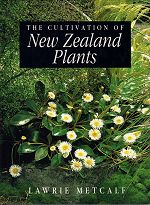
|
The
Cultivation of New Zealand Plants Reviewed by Mike Oates Over the past thirty years Lawrie Metcalf has made an enormous contribution to our understanding and enjoyment of native plants. He is perhaps best known to New Zealanders for his landmark publication The Cultivation of New Zealand Trees and Shrubs, a book that bridged the gap between horticulture and botany. Less known has been his work for the RNZIH as convenor of the Nomenclature Committee overseeing the publication of checklists of native plant cultivars. He is currently working on the Hebe checklist, a massive undertaking which includes over 900 cultivars. It is planned to publish this in 1994. Lawrie Metcalf is one of New Zealand's great plantsmen, whose knowledge of plants has been gained from study in their natural habitat as well as in cultivation. This knowledge is reflected in his latest book, The Cultivation of New Zealand Plants, which deals with herbaceous plants, ferns, grasses, grass-like plants, and small shrubs. This book, as he explains in the introduction, has had a long gestation, and was originally scheduled to appear soon after the publication of The Cultivation of New Zealand Trees and Shrubs. Work pressures and later a deteriorating economy meant it was put on hold. With the publication of this book and the recent updating of the book on trees and shrubs, Metcalf has put the cap on a remarkable career. The format of the book follows closely that of its sister publication. Part 1 contains a general introduction to growing the plants, including methods of cultivation and propagation. Detailed information is given about alpine and shade houses and the construction of scree and moraine gardens. Finally, a useful chapter on plants for different situations and problems that are likely to occur and how they can be remedied. Part 2 contains an alphabetical listing of the genera, followed by general information about propagation, cultivation and pest and disease problems. Then follows a botanical description of the garden worthy species and/or cultivars in that genus, including detailed information on the cultivation of these plants. All in all it provides information on 114 genera and over 360 species. The book concludes with a comprehensive glossary and a chapter on early botanists and horticulturists and their role in introducing N.Z. natives into cultivation. Having used Metcalf's first book as a standard text for many years, I find it invaluable to have the same treatment applied to the rest of the higher plant flora. The strength of this book is the linking of botanical and ecological information with cultural details. With the plethora of gardening books on the market today it is refreshing to find one that deals with a subject in real depth and relies on first-hand quality information rather than the regurgitation and lack of research common in many popular publications. The book covers well known as well as rarely cultivated plants and will certainly encourage people to grow a wider range of natives. One of the problems that will always remain, however, is how people can get hold of the plants. A short list of suppliers would have been helpful, especially details of the New Zealand Alpine Garden Society, an organisation that produces an excellent seed list. Metcalf mentions at the start the difficulty of choosing which plants to put in the book. There are always going to be pressures on space and not everyone will agree with the choice. Certainly the selection is comprehensive and includes many of the plants successfully grown at Otari and recognised as being garden-worthy. It also includes plants that we aren't growing now but that would be worth trying. A couple of conspicuous omissions include Aciphylla squarrosa, a very useful species that is hardy and easy to grow, if not quite as showy as some of the other Spaniards such as A. glaucescens. Also omitted, possibly because of publishing deadlines, are the new Jury Celmisia hybrids that are easily grown and provide spectacular flowering during spring. Congratulations too for the excellent colour photographs in the centre of the book, which complement the text so well and provide the proof that our flora is anything but boring. The variation in foliage, form and flowers is staggering. Having used the book I find it hard to criticise it except in one fundamental area, that being its title. It is downright confusing, and many staff who looked at the book and who were unfamiliar with its sister publication got horribly confused looking for trees and shrubs. Not every book buyer reads the introduction and dust cover before buying it, and I'm sure some readers and buyers are going to be disappointed when they find out it isn't what it says it is. I can see the reasons for calling it 'plants', but I believe a mistake was made, and it should have been called what it is, 'The Cultivation of N.Z. Herbaceous Plants, Ferns, and Grasses'. In concluding, I would recommend that anyone serious about natives and wanting to increase the number they grow should read this book and use it. Together with its companion volume (with which I hope it will soon be sold as a set) it offers the most comprehensive horticultural treatment of New Zealand plants ever published. Horticulture in New Zealand: Journal of the Royal New Zealand Institute of Horticulture 1993 4(2): 19 |
Home | Journal
| Newsletter | Conferences
Awards | Join
RNZIH | RNZIH Directory | Links
© 2000–2024 Royal New Zealand Institute of Horticulture
Last updated: March 1, 2021

 BOOK
REVIEWS
BOOK
REVIEWS